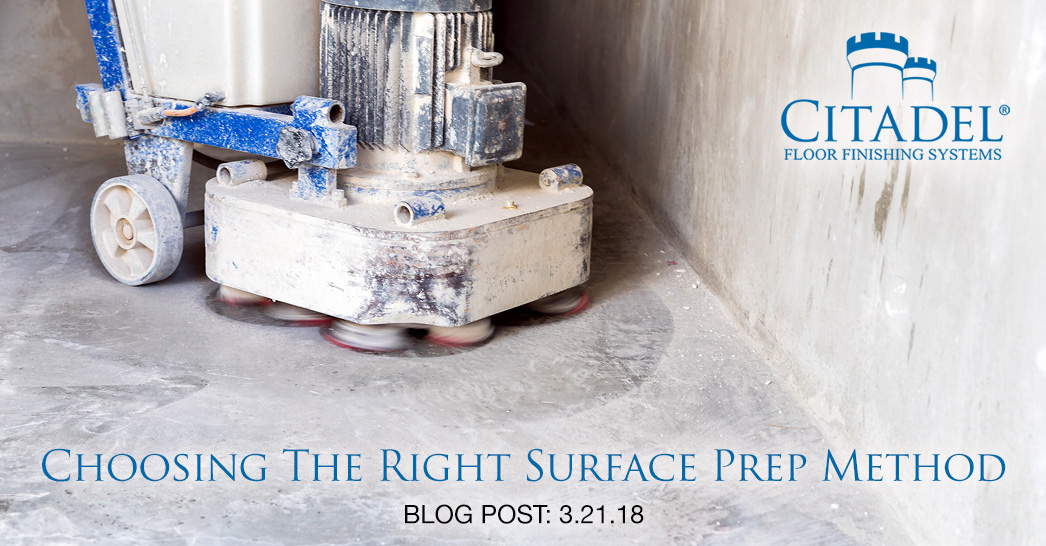Avoid Concrete Coating Failures: Choose the Right Surface Preparation Method for the Job

2018-03-21
As any good installer knows, proper surface preparation, or profiling, is required so the concrete bonds to the coating. Profiling, or opening the pores of concrete surfaces, allows coatings to penetrate and achieve a proper bond. Without profiling, coatings fail.
No matter how good the coating system is, a misstep during preparation sets the stage for expensive repairs and replacement down the line—as well as unhappy clients. The right surface prep method, however, ensures adhesion to the substrate and extends the coating’s life.
You can think of the decision-making steps as a process of elimination:
1) Is this surface appropriate to profile? Can the surface take a coating?
Do your due diligence. Testing and in-depth inspection are your best bets in this process.
The first thing you want to know is whether the concrete surface has already been covered with sealers, contaminants, curing compounds, oil, grease or any other materials. These things make the concrete surface too dense to accept a penetrating primer.
How do you test for sealers, etc.? Easy. Water beading on your concrete’s surface means it’s sealed. Any previous coatings will need to be removed before a surface can be coated.
Next, test for moisture and relative humidity (RH) levels. This is a must-do for every installer, before any type of concrete coating. Excess moisture in the concrete has nowhere to go once the surface is coated, causing bubbling, and attacking of the bond line. Too much moisture is one of the major causes for coating failures.
Once you know whether your concrete surface is sealed and has a workable moisture level, your next decision is:
2) Acid etch or grind?
Most surfaces require mechanical grinding, since it blasts through any surface contaminants that acid etch can’t, but there are times when you’ll want to use the chemical alternative.
Acid etching involves pouring an acid solution to profile the concrete surface. Muriatic acid is most commonly used, but it is very corrosive. There are safe acid-etch solutions that have the same effect without harsh odors, dangerous chemicals or the need to neutralize afterward.
Relatively easy to perform and less costly than grinding, acid etching is an appealing option – especially to reach irregular, hard-to-get areas.
However, acid etch doesn’t remove sealant or all traces of laitance. So, if your floor failed the water-beading test, mechanical prep is the way to go. So if you’ve eliminated acid-etch as a solution, your next decision becomes:
3) Which preparation method is the best?
Surface preparation refers to mechanical techniques that profile the surface of the concrete, removing glues, paints, sealants, laitance, and other contaminants that can impact the success or failure of your floor coating. Tools vary depending on the size, budget and type of flooring project.
Surface preparation offers the best control of your surface’s final profile uniformity and desired surface texture. It requires a little more investment, for purchase or rental of equipment, and requires some skill and training to operate the machines.
Tune in next week when we’ll cover three primary surface preparation methods: shot blasting, diamond grinding, and scarifying—and when to do what.
Choosing the best method to profile your concrete surface? We can help. We offer handheld grinders, as well as safe acid etching solutions. Our experts can walk you through determining the best surface preparation method for your concrete floor coating project. Click here to schedule a call.
Latest News
How to Maintain Your Concrete Grinder
Gain Customers and Referrals in 4 Easy Steps
Ready for the Summer Rush? 4 Ways to Prepare
6 Cold Weather Safety Tips for Installers
How to Remove Salt Stains from Concrete
Testimonials
Every time I call I get to talk to someone, and I always have an answer within 20 minutes. That's awesome.
Client: Terry C.

